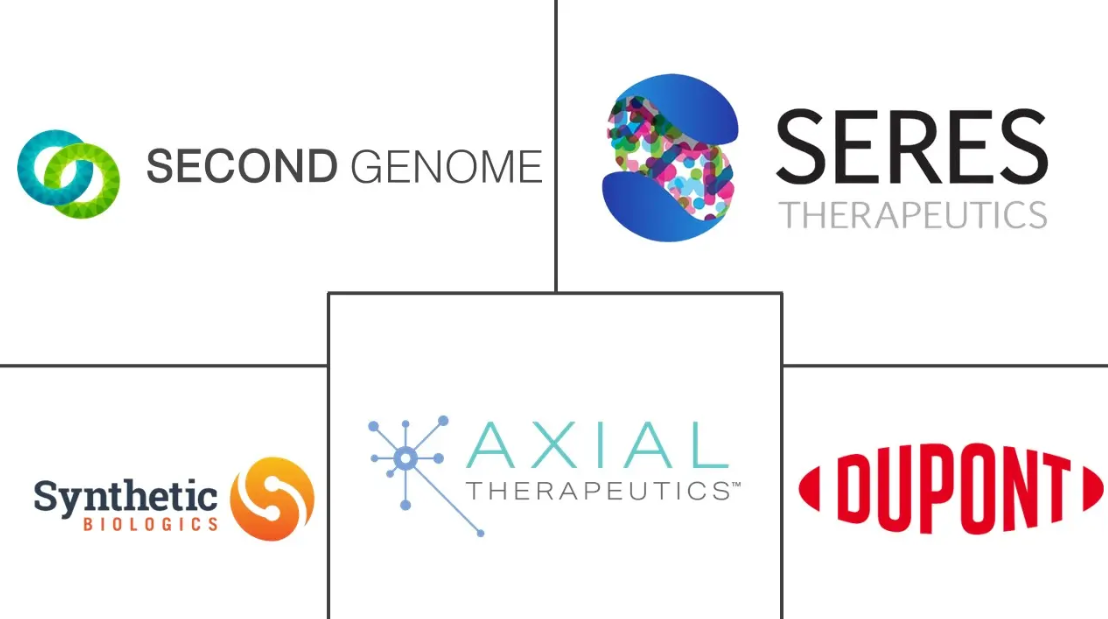Human Microbiome Market Size & Share Analysis – Growth Trends & Forecasts (2025 – 2030)
The Human Microbiome Market is segmented by Application (Therapeutics and Diagnostics), Disease (Obesity, Diabetes, Autoimmune Disorder, Cancer, Gastrointestinal Disorders, Central Nervous System Disorders, and Other Diseases), Product (Probiotics, Prebiotics, Symbiotic, and Other Products), and Geography (North America, Europe, Asia-Pacific, Middle-East and Africa, and South America). The Market Size and Forecasts are Provided in Terms of Value (USD Billion) for all the Above Segments in this Industry Report.
Human Microbiome Market Size & Share Analysis – Growth Trends & Forecasts (2025 – 2030)
Human Microbiome Market Size
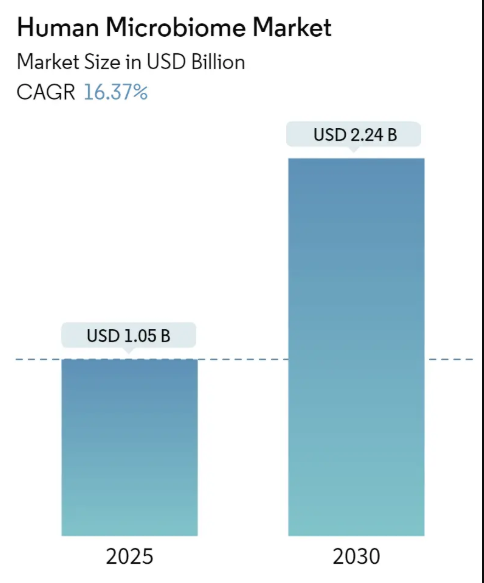
| Study Period | 2019 – 2030 |
| Base Year For Estimation | 2024 |
| Market Size (2025) | USD 1.05 Billion |
| Market Size (2030) | USD 2.24 Billion |
| CAGR (2025 – 2030) | 16.37 % |
| Fastest Growing Market | Asia-Pacific |
| Largest Market | North America |
Major Players
*Disclaimer: Major Players sorted in no particular order |
Compare market size and growth of Human Microbiome Market with other markets in Healthcare Industry
Biotechnology
Pharmaceuticals
Healthcare IT
Medical Devices
Animal Health
Device Drug Combination
Human Microbiome Market Size & Share Analysis – Growth Trends & Forecasts (2025 – 2030)
| Study Period: | 2019 – 2030 |
| CAGR: | 16.37% (2025 – 2030) |
| Countries/ Region Covered: | North America,Europe,Asia-Pacific,Middle East and Africa,South America |
| Major Players: | DuPont, Seres Therapeutics, Second Genome, Synthetic Biologics, Axial Biotherapeutics |
Human Microbiome Market Analysis
The Human Microbiome Market size is estimated at USD 1.05 billion in 2025, and is expected to reach USD 2.24 billion by 2030, at a CAGR of 16.37% during the forecast period (2025-2030). The increasing need for human microbiome therapeutics to treat various conditions such as diabetes, asthma, metabolic disorders, and others and the widespread occurrence of lifestyle-related diseases is likely to drive significant demand for these products, resulting in market growth throughout the forecast period.
For instance, a study published by the Institute for Health Metrics and Evaluation in June 2023 reported that the global diabetic patient population is expected to reach 1.3 billion by 2050. In addition, the data published by the Global Initiative For Asthma Organization in May 2024 reported that asthma ranks among the most prevalent chronic non-communicable diseases, impacting more than 260 million individuals globally each year. Thus, the growing burden of lifestyle-related disorders is likely to drive the demands for human microbiome therapeutics, hence contributing to the market growth.
The human microbiome gained attention due to its links to various respiratory diseases and immune function. This led to increased clinical research activities, thus contributing to the market growth. For instance, in September 2024, researchers from the Nuffield Department of Medicine identified a connection between certain potentially harmful bacteria and airway inflammation in individuals suffering from severe asthma. The team observed that healthy individuals and those with mild asthma microbiomes exhibited comparable microbial diversity. However, in individuals with severe asthma, 23% of the microbiomes were predominantly influenced by one of three respiratory pathogens: Haemophilus influenzae, Moraxella catarrhalis, or Streptococcus pneumoniae.
Additionally, a study published in the Journal of Cell in August 2024 involved a group of researchers from the Netherlands who examined nasopharyngeal, oropharyngeal, and saliva samples from different age groups and investigated the microbial composition of these samples to explore the relationship between the microbiota in the upper respiratory tract. Research indicated that the upper respiratory tract microbiome is closely connected to respiratory health and significantly influences susceptibility to respiratory infections. Thus, such studies indicate the relationship between human microbiome and respiratory diseases, creating more opportunities for market players to develop products, thus contributing to market growth.
The above-mentioned factors, such as the increasing prevalence of lifestyle-related diseases and rising clinical research studies, are anticipated to drive the demand for human microbiomes and contribute to the market’s growth. However, a lack of comprehensive research and stringent government regulations may hinder the market growth over the forecast period.
Human Microbiome Market Trends and Insights
Therapeutics Segment is Anticipated to Exhibit the Largest Market Share as per this Market Forecast
By application, the therapeutics is anticipated to show the fastest growth, with a compound annual growth rate (CAGR) of 21.10% from 2024 to 2029. The industry analysis projects that this segment will register a market value of USD 0.87 billion in 2024 and reach USD 1.94 billion by 2029.
Microbiome therapeutics have numerous applications in conditions such as inflammatory bowel disease (IBD), C. difficile infections, Crohn’s disease, and diabetes. The growth of this market segment is driven by increased research initiatives from academic institutions, market leaders, and industry players seeking new therapeutic uses for the human microbiome, alongside the escalating incidence of various diseases. For instance, an article published by the Lancet Gastroenterology & Hepatology in May 2024 mentioned that microbiota therapies involving the transfer of fecal matter from healthy donors to individuals with mild-to-moderate ulcerative colitis demonstrated the ability to achieve remission in approximately 30% of participants in clinical trials in 2022. Additionally, in December 2023, researchers at Vanderbilt University found that the bacteria in the small intestines generate a compound called phenyllactic acid that helps guard against obesity. As a result of these and similar studies, the segment is projected to experience significant growth throughout the forecast period.
Furthermore, the agreements and collaborations among key players also enhance segment growth, helping these companies solidify their positions in the industry. For instance, in November 2024, Nexilico and Siolta Therapeutics, a frontrunner in creating live biotherapeutic products (LBPs), collaborated to tackle necrotizing enterocolitis (NEC) through cutting-edge microbial therapeutics. This alliance merges Nexilico’s versatile artificial intelligence (AI)-driven discovery platform with Siolta’s proficiency in developing targeted biotherapeutics, paving the way for groundbreaking treatment strategies in infant health. Thus, the rise in strategic activities, such as collaborations adopted by the market players, is likely to contribute to market growth.
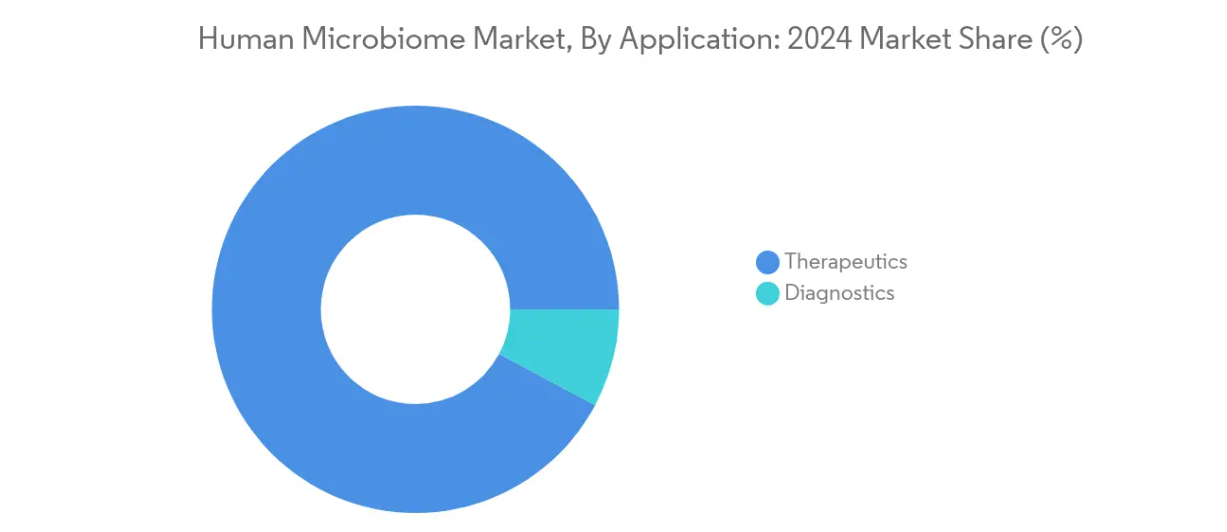
Autoimmune Disorders Segment is Projected to Occupy a Significant Human Microbiome Market Share Throughout the Forecast Period
In terms of disease segment, the autoimmune disorders segment is expected to capture the largest market share, registering a CAGR of 22.43% throughout the forecast period (2024 – 2029), and the segment is expected to register market size of USD 0.12 billion in 2024, further reaching to USD 0.26 billion by 2029. Various research studies are conducted to explore the potential benefits of probiotics for preventing and treating a range of systemic conditions, encompassing inflammatory and autoimmune diseases such as rheumatoid arthritis, ulcerative colitis, multiple sclerosis, and hepatic encephalopathy.
The benefits of probiotics include modulating immune system function, which often varies depending on the specific strain of probiotic bacteria used. Certain strains have shown the ability to enhance the immune response, thus providing advantages for individuals with immunodeficiencies. Hence, such products are likely to be adopted to enhance the human microbiome and reduce the severity of autoimmune disorders, thus contributing to the segment growth.
The human microbiome market is segmented by application, disease, and product. By application, the market is segmented into therapeutics and diagnostics. By disease, the market is segmented into obesity, diabetes, autoimmune disorders, cancer, gastrointestinal disorders, central nervous system disorders, and other diseases. The other diseases for which the human microbiome may be useful are anxiety disorders, wound healing, tuberculosis, multidrug-resistant bacterial infections, fungal infections, and cardiovascular disease. By product, the market is segmented into probiotics, prebiotics, symbiotics, and other products. Other products include medical food supplements and antibiotics. This segmentation emphasizes the various applications and potential growth opportunities for human microbiome market size, influenced by its significance in health and disease management.
North America Human Microbiome Market is Expected to See Significant Growth During the 2024 – 2029 Period
The North American market is projected to account for a significant share, with estimates indicating a size of USD 0.62 billion in 2024 and an expected increase to USD 1.18 billion by 2029. The North American human microbiome market is anticipated to expand throughout the forecast period, driven by several factors, such as the increasing incidence of various lifestyle diseases in the region- including in the United States, Canada, and Mexico, the surge in clinical studies related to the human microbiome, a robust presence of industry participants, and an enhanced healthcare infrastructure.
The increasing prevalence of lifestyle diseases such as stomach cancer, diabetes, and others is anticipated to drive the demand for product types and products such as probiotics and prebiotics to improve gut microbiome, thus contributing to market growth. For instance, according to the data published by the American Cancer Society in January 2024, around 26.8 thousand new stomach cancer cases were expected to be diagnosed in the United States in 2024, an increase from 26.5 thousand new stomach cancer cases in 2023. Additionally, according to the data published by the Canadian Diabetes Association in February 2024, around 4 million individuals were estimated to be diagnosed with diabetes in Canada in 2024, and it is anticipated to reach 5.3 million by 2034. Hence, the rising prevalence of lifestyle disorders such as cancer and diabetes across North America is likely to create a demand for the human microbiome market during the forecast period.
The rising clinical research studies investigating the microbiome’s association with medical disorders are also anticipated to drive market growth. For instance, in October 2024, a research team from the University of California made significant progress in uncovering the origins of Parkinson’s disease, discovering that this incurable condition seems to originate in the human gut. The interdisciplinary team discovered that the protein fragments that cluster in the brain and contribute to Parkinson’s are believed to form in the intestine due to the presence of the well-known E. coli bacteria that inhabit the human digestive system. Additionally, in September 2024, the Biocodex Microbiota Foundation invited academics and scientists from Canada to apply for a USD 27.5 thousand (EUR 25 thousand)) research grant to enhance the study of microbiota’s role in health and diseases. Thus, the increasing clinical research activities are anticipated to contribute to the market growth in the region.
By geography, the global market is segmented into North America (United States, Canada, Mexico), Europe (Germany, United Kingdom, France, Italy, Spain, Rest of Europe), Asia-Pacific (China, Japan, India, Australia, South Korea, Rest of Asia-Pacific), Middle East and Africa (GCC, South Africa, Rest of Middle East and Africa), and South America (Brazil, Argentina, Rest of South America). The East Africa and Asia-Pacific regions, especially countries like China, Japan, and India, are witnessing rapid growth fuelled by the high incidence of lifestyle diseases and the expanding elderly population; there is a rising demand for the diagnosis and treatment of lifestyle-related conditions through the human microbiome therapies, contributing to the APAC market growth.
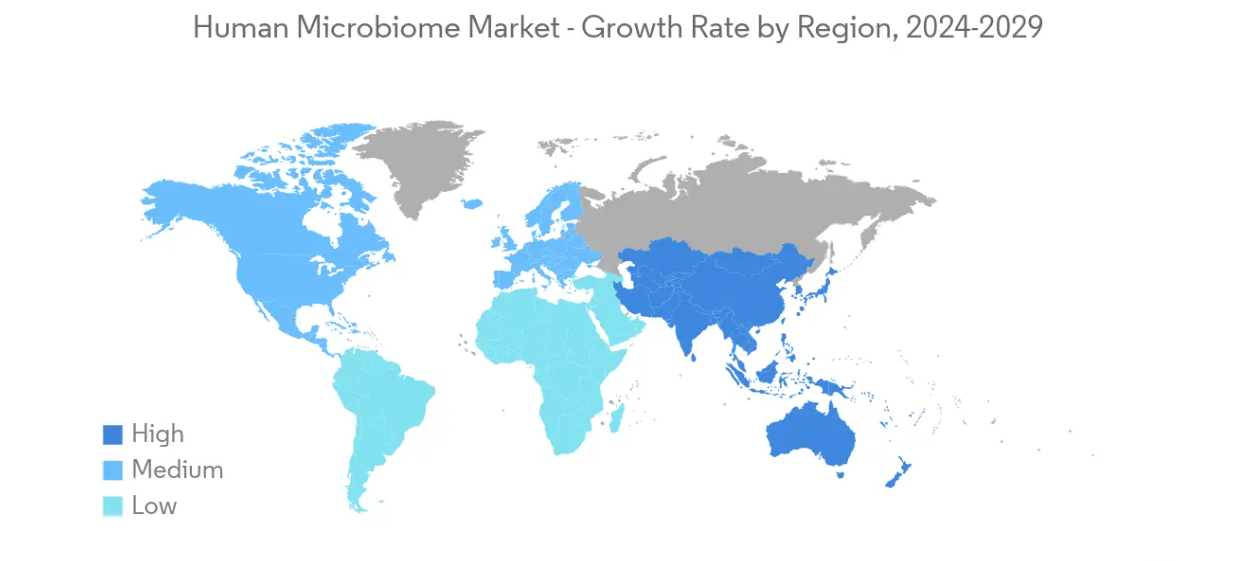
Human Microbiome Industry Overview
The market for human microbiome is semi-consolidated, and several players are coming up with new products. Some of the key players in the human microbiome market are AOBiome, ResBiotic Nutition Inc., Axial Biotherapeutics Inc., International Flavors & Fragrances Inc., Enterome, Evelo Biosciences Inc., Finch Therapeutics Group Inc., Microba, Exeliom Biosciences SAS, Osel Inc., Second Genome Inc. and Seres Therapeutics, among others. The market exhibits moderate competitiveness, with various companies introducing innovative products.
Companies hold significant market shares and focus on prioritizing improving their therapeutics pipeline by creating effective and safe medications. For instance, in October 2024, AOBiome Therapeutics, Inc. received a patent grant from the United States Patent Office (USPTO) for the composition of matter. This patent covered claims about its exclusive strain of beneficial ammonia-oxidizing bacteria (AOB), classified as Nitrosomonas eutropha. The company’s clinical candidate B244 has shown effectiveness in treating several conditions, including mild-to-moderate atopic dermatitis (eczema) along with associated moderate-to-severe pruritus (itch) and mild-to-moderate acne vulgaris (acne).
Thus, the regulatory approvals and patent filings for innovations in products are likely to drive market growth.
Human Microbiome Market Leaders
-
- Second Genome Inc
- Seres Therapeutics
- Axial Biotherapeutics Inc
- DuPont
- Synthetic Biologics.
- *Disclaimer: Major Players sorted in no particular order
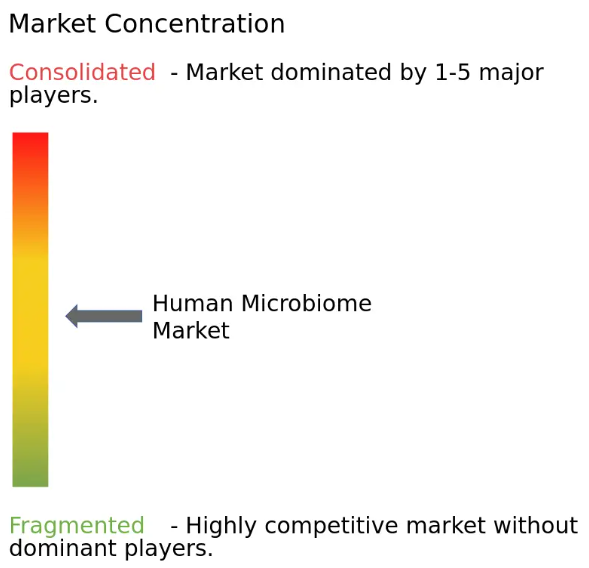
Human Microbiome Market News
- November 2024: MicrobioTx, based in Bangalore, launched a new gut health test that analyzes the gut microbiome through a simple finger-prick blood sample in India. This advancement allows for gut microbiome profiling with just a finger-prick, which previously could only be done using stool samples, thus eliminating the need for stool collection.
- September 2024: Microbiome company Seed entered the physical retail space for the first time through an exclusive partnership with Target. Target will offer Seed’s products both in-store and online, featuring the DS-01 Daily Synbiotic, PDS-08 Pediatric Daily Synbiotic, and a new exclusive item, the DS-01 14 Day Daily Gut Reset.
- September 2024: Floré introduced its latest line of probiotics specifically created to support neurodiversity. The new offerings, Pathways Support and Mood Support, have beneficial effects of customized probiotic supplementation for individuals with autism spectrum disorder (ASD). Each product contains 30 capsules and can be purchased as a one-time order or through a monthly subscription.
- April 2024: Seres Therapeutics, Inc. mentioned that enrolment has been completed for the placebo-controlled cohort-2 of its Phase-1b trial evaluating SER-155 in patients who have undergone allogeneic hematopoietic stem cell transplantation (Allo HSCT). SER-155 is an orally taken consortium of bacteria, developed from cell banks to decrease the occurrence and severity of infections originating from the digestive tract, as well as related bloodstream infections, including those potentially resistant to antibiotics.
Human Microbiome Market Report – Table of Contents
1. INTRODUCTION
- 1.1 Study Assumptions and Market Definition
- 1.2 Scope of the Study
2. RESEARCH METHODOLOGY
3. EXECUTIVE SUMMARY
4. MARKET DYNAMICS
- 4.1 Market Overview
- 4.2 Market Drivers
- 4.2.1 Increasing Incidence of Lifestyle-related Diseases
- 4.2.2 Growing Geriatric Population
- 4.3 Market Restraints
- 4.3.1 Lack of Comprehensive Research
- 4.3.2 Stringent Government Regulations
- 4.4 Porter’s Five Forces Analysis
- 4.4.1 Threat of New Entrants
- 4.4.2 Bargaining Power of Buyers/Consumers
- 4.4.3 Bargaining Power of Suppliers
- 4.4.4 Threat of Substitute Products
- 4.4.5 Intensity of Competitive Rivalry
5. MARKET SEGMENTATION (Market Size by Value in USD Billion)
- 5.1 Therapeutics
- 5.1.1 Diagnostics
- 5.2 By Disease
- 5.2.1 Obesity
- 5.2.2 Diabetes
- 5.2.3 Autoimmune Disorders
- 5.2.4 Cancer
- 5.2.5 Gastrointestinal Disorders
- 5.2.6 Central Nervous System Disorders
- 5.2.7 Other Diseases
- 5.3 By Product
- 5.3.1 Probiotics
- 5.3.2 Prebiotics
- 5.3.3 Symbiotics
- 5.3.4 Other Products
- 5.4 By Geography
- 5.4.1 North America
- 5.4.1.1 United States
- 5.4.1.2 Canada
- 5.4.1.3 Mexico
- 5.4.2 Europe
- 5.4.2.1 Germany
- 5.4.2.2 United Kingdom
- 5.4.2.3 France
- 5.4.2.4 Italy
- 5.4.2.5 Spain
- 5.4.2.6 Rest of Europe
- 5.4.3 Asia-Pacific
- 5.4.3.1 China
- 5.4.3.2 Japan
- 5.4.3.3 India
- 5.4.3.4 Australia
- 5.4.3.5 South Korea
- 5.4.3.6 Rest of Asia-Pacific
- 5.4.4 Middle East and Africa
- 5.4.4.1 GCC
- 5.4.4.2 South Africa
- 5.4.4.3 Rest of Middle East and Africa
- 5.4.5 South America
- 5.4.5.1 Brazil
- 5.4.5.2 Argentina
- 5.4.5.3 Rest of South America
6. COMPETITIVE LANDSCAPE
- 6.1 Company Profiles
- 6.1.1 Aobiome
- 6.1.2 Resbiotic Nutition Inc.
- 6.1.3 Axial Biotherapeutics Inc.
- 6.1.4 International Flavors & Fragrances Inc.
- 6.1.5 Enterome
- 6.1.6 Evelo Biosciences Inc.
- 6.1.7 Finch Therapeutics Group Inc.
- 6.1.8 Microba
- 6.1.9 Exeliom Biosciences SAS
- 6.1.10 Osel Inc.
- 6.1.11 Second Genome Inc.
- 6.1.12 Seres Therapeutics
- *List Not Exhaustive
Human Microbiome Industry Segmentation
As per the scope of the report, the human microbiome is a full array of microorganisms (the microbiota) that live in humans. More specifically, the collection of microbial genomes that contribute to a human’s broader genetic portrait, or metagenome.
The human microbiome market is segmented by application, disease, and product. By applications, the market is segmented into therapeutics and diagnostics. By disease, the market is segmented into obesity, diabetes, autoimmune disorders, cancer, gastrointestinal disorders, central nervous system disorders, and other diseases. By products, the market is segmented into probiotics, prebiotics, symbiotics and other products. By geography, the global market is segmented into North America (United States, Canada, Mexico), Europe (Germany, United Kingdom, France, Italy, Spain, Rest of Europe), Asia-Pacific (China, Japan, India, Australia, South Korea, Rest of Asia-Pacific), Middle East and Africa (GCC, South Africa, Rest of Middle East and Africa), and South America (Brazil, Argentina, Rest of South America). The market report also covers the estimated human microbiome market size and market trends for 17 countries across major regions globally. The report offers the value (in USD billion) for the above segments

